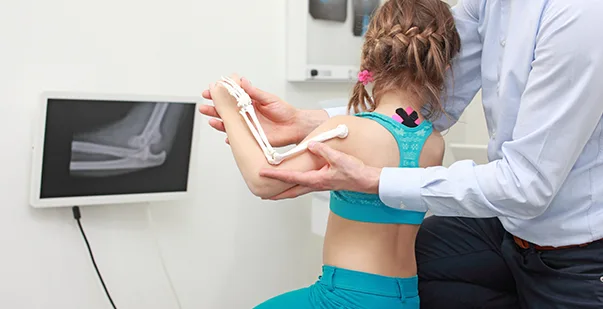Table of Contents
- Introduction
- The Challenges of Pediatric Elbow Radiographs
- Essential Radiographic Views
- Systematic Approach to Pediatric Elbow x rays
- Special Considerations Cases
- Special Considerations for Different Age Groups
- Common Pitfalls and How to Avoid Them
- Conclusion
Introduction
Every day, medical professionals worldwide face a common yet daunting challenge: analyzing pediatric elbow X-rays. As your eyes scan the image, you try to understand and observe any potential fractures, where ossification centers—areas of bone formation—become difficult to spot.
It might be surprising to know that pediatric elbow fractures represent up to 10% of all fractures among children. In this fracture, a subtle injury could be hiding in plain sight, covered by the natural gaps of a growing elbow. Now, this isn’t just an occasional hurdle—it’s a recurring test of skill and knowledge that can complicate matters even for seasoned practitioners.
But what if you could approach these x-rays confidently? Our comprehensive guide on understanding pediatric elbow x-rays can help you whether you’re an experienced radiologist or a medical student. So, let’s jump right in.
Master ACLS Now
Get ACLS certified with confidence
The Challenges of Pediatric Elbow Radiographs
Pediatric elbow radiographs present several unique challenges compared to adult radiographs. Unlike adults, children have multiple ossification centers or first bone formation sites. So, it is very difficult to differentiate normal anatomy from fractures. Key challenges include:
- Multiple ossification centers with age-dependent appearance
- Subtle fracture patterns that may be easily overlooked
- Variations in normal anatomy based on the child’s age and developmental stage
- Difficulty in obtaining optimal positioning for radiographs in young or uncooperative patients
Understanding these challenges is the first step in developing a systematic approach to pediatric elbow radiograph interpretation. Additionally, having a CPR certification can be beneficial for healthcare professionals working with pediatric patients, ensuring they are prepared for any emergencies that may arise during the examination process.
Systematic Approach to Pediatric Elbow x rays
When faced with a pediatric elbow x-ray, it’s necessary to follow a structured approach so that no important findings are missed. This systematic method improves diagnostic accuracy.
By following the steps outlined in this guide, you’ll be better equipped to differentiate between normal anatomical variations and abnormal findings in the pediatric elbow.
Step 1: Assessing Image Quality
Before you begin the interpretation, it’s important to ensure that the radiographs are of adequate quality. For a pediatric elbow x-ray, two standard views are typically needed:
- Anteroposterior (AP) view (From front to back): The elbow should be in full extension with the forearm supinated.
- Lateral view ( Visual perspective from the side): The elbow should be flexed at 90 degrees with the forearm in a neutral position.
- External oblique view ( projection of images that can be used to separate structure): Useful for visualizing the lateral condyle and capitellum.
Ensure that both views are properly positioned and that all relevant anatomical structures are visible. A normal pediatric elbow x-ray should clearly show the distal humerus, proximal radius and ulna, and surrounding soft tissues.
Step 2: Identifying Ossification Centers
One of the unique challenges in understanding pediatric elbow radiographs is the presence of multiple ossification centers that appear and fuse at different ages. Familiarity with these centers is crucial for differentiating normal anatomy from fractures. The mnemonic “CRITOE” is helpful for remembering the order of ossification center appearance:
- C: Capitellum (appears at 1-2 years)
- R: Radial head (appears at 2-4 years)
- I: Internal (medial) epicondyle (appears at 4-6 years)
- T: Trochlea (appears at 8-10 years)
- O: Olecranon (appears at 9-11 years)
- E: External (lateral) epicondyle (appears at 10-12 years)
When examining a pediatric elbow radiograph, always consider the patient’s age and compare the visible ossification centers to what would be expected for that age group. For example, in a woman elbows 12 years old, all ossification centers should be visible, but they may not have completely fused yet.
Step 3: Evaluating Soft Tissue Swelling and Joint Effusion
Soft tissue swelling and joint effusion can be important indicators of underlying pathology in the pediatric elbow. On a lateral view, look for:
- Anterior fat pad sign: A small amount of fat anterior to the distal humerus is normal. However, if it appears elevated or “sail-like,” it may indicate a joint effusion.
- Posterior fat pad sign: Although normally not visible, the presence of a posterior fat pad is always abnormal and suggests an elbow X-ray with effusion.
An occult fracture elbow may present with only soft tissue swelling or a joint effusion without a visible fracture line. In such cases, clinical correlation and follow-up imaging may be necessary.
Step 4: Checking Alignment
Proper alignment is crucial for a healthy normal elbow x-ray child. Two important lines to assess are:
- Anterior humeral line: On a lateral view, draw a line along the anterior cortex of the humerus. This line should intersect the middle third of the capitellum in children over 4 years old. If it passes anterior to the capitellum, suspect a supracondylar fracture.
- Radiocapitellar line: On any view, a line drawn through the long axis of the radial neck should intersect the capitellum. If it doesn’t, consider a radial head dislocation or fracture.
Step 5: Examining Bone Cortices
Carefully inspect the cortices of all visible bones in the pediatric elbow x-ray. Look for any irregularities, breaks, or subtle buckle fractures. Pay particular attention to:
- The supracondylar region of the humerus
- Lateral condyle
- Medial epicondyle
- Radial neck
- Olecranon process
Remember that in children, fractures may be incomplete (greenstick fractures) or involve the growth plate (Salter-Harris fractures), which can be subtle on radiographs.
Step 6: Focused Search for Common Fractures
Based on the patient’s history and clinical examination, conduct a focused search for common pediatric elbow fractures. Some of the most frequent fractures include:
1. Supracondylar Fractures
Supracondylar fractures are the most common elbow fractures in children, typically occurring between ages 5-7. They are classified into two types:
- Extension type (95%): Look for the posterior displacement of the distal fragment
- Flexion type (5%): Look for the anterior displacement of the distal fragment
Key radiographic signs:
- Displaced anterior humeral line
- Posterior fat pad sign
- “S-shaped” anterior humeral cortex on lateral view
2. Lateral Condyle Fractures
These are the second most common elbow fractures in children. Look for:
- Irregularity or step-off in the lateral condylar physis
- Displacement of the capitellum
- Widening of the soft tissue lateral to the elbow
3. Medial Epicondyle Fractures
Often associated with elbow dislocations, these fractures can be easily missed. Look for:
- Displacement of the medial epicondyle
- Intra-articular entrapment of the epicondyle fragment
4. Radial Head and Neck Fractures
These fractures are more common in older children and adolescents. Look for:
- Displacement or angulation of the radial head
- Fat pad signs
- Abnormal radiocapitellar alignment
5. Elbow Dislocations
While less common in children, elbow dislocations can occur, often in association with fractures. Look for:
- Loss of normal articulation between the humerus, radius, and ulna
- Associated fractures, particularly of the medial epicondyle
Special Cases of Pediatric Elbow Fractures
Along with common cases, here are some special cases of pediatric elbow fractures.
1 Occult Fractures
An occult fracture elbow can be challenging to diagnose on initial radiographs. Consider this diagnosis when:
- There is a positive fat pad sign without a visible fracture
- Clinical suspicion is high despite normal-appearing radiographs
In these cases, consider:
- Immobilization and follow-up radiographs in 7-10 days
- Advanced imaging such as MRI or CT, if clinically indicated
2 Fat Pad Signs
Fat pad signs are crucial indicators of joint effusion and potential occult fractures:
- Anterior fat pad: A small amount is normally visible on lateral views
- Posterior fat pad: Not normally visible; its presence indicates an effusion
- Sail sign: Elevation and anterior displacement of the anterior fat pad
3 Comparative Views
While comparative views of the contralateral elbow are not routinely recommended due to increased radiation exposure, they may be helpful in select cases:
- When distinguishing normal ossification centers from fractures
- In cases of suspected subtle displacement or angulation
Interpretation Based on Different Age Groups
The interpretation of pediatric elbow radiographs varies depending on the child’s age due to the progressive ossification of growth centers. Consider the following age-specific factors:
- Infants (0-1 year): The capitellum is the only visible ossification center. The elbow appears largely cartilaginous on x-rays.
- Toddlers (1-3 years): The capitellum and radial head ossification centers become visible. Be cautious not to mistake these normal centers for fracture fragments.
- Preschoolers (3-5 years): The medial epicondyle ossification center appears. The anterior humeral line becomes a reliable indicator of alignment.
- School-age children (5-12 years): The remaining ossification centers are gradually appearing. All centers should be visible by age 12 in girls and 14 in boys.
- Adolescents (12+ years): Ossification centers begin to fuse. Be aware of normal fusion times to avoid misinterpreting them as fractures.
Common Pitfalls and How to Avoid Them
- Mistaking normal ossification centers for fracture fragments: Always consider the patient’s age and the expected appearance of ossification centers.
- Overlooking subtle fractures: Use a systematic approach and carefully examine all bone cortices.
- Misinterpreting a normal pediatric elbow x-ray as abnormal: Familiarize yourself with age-specific normal appearances to avoid overcalling normal variants as pathology.
- Failing to recognize an elbow dislocation: Always check the radiocapitellar line on all views.
- Overlooking-associated injuries: Remember to examine the entire visible anatomy, including the proximal forearm and distal humerus.
Final Thoughts
To correctly Interpret pediatric elbow radiographs, you need to know a lot about developmental anatomy and a systematic approach to image analysis. Clinicians can be more sure of their diagnoses and accuracy when looking at pediatric elbow injuries if they follow the steps in this guide. These steps include checking the quality of the image and searching specifically for common fractures.
Keep in mind that X-rays are only one part of the diagnostic process. Always compare what the imaging shows to how the patient is acting, and if you’re not sure, get more imaging or talk to an expert. Reading X-rays of a child’s elbow will get easier and more fun as they get more experience.







